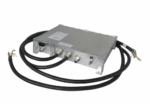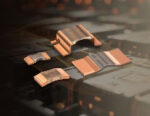Bel Fuse Inc. is announcing the release of its BCN25-1000 Series — a 25 kW, liquid-cooled battery charger that converts 3-phase AC voltage to DC voltage.
Battery and Battery Management
Active clamp flyback controller integrates adaptive digital pwm control with ultra-high-voltage components
Silanna Semiconductor has expanded its CO2 Smart Power Family of AC/DC and DC/DC converter technologies with the launch of an active clamp flyback (ACF) controller that integrates adaptive digital PWM control with ultra-high-voltage (UHV) components comprising a 700 V primary GaN FET, X capacitor (X-Cap) discharge circuit, active clamp driver and start-up regulator. Silanna’s CO2 […]
TTape: A simple way to monitor Li-ion battery-pack temperature
A set of temperature-triggered switches alerts you to hot batteries. Li-ion batteries can get hot, which can cause failures or worse in the products they power. Thus, it’s important to monitor their temperature and act before damage occurs. You can monitor temperature with a set of thermocouples, scan them, and write software to produce an […]
Current sense resistors feature low TCR
Bourns, Inc. introduced four high-power, ultra-low ohmic current sense resistor series. The latest current measurement devices from Bourns are designed to help save energy while maximizing sensing performance in power electronics designs. The four CSI Model Series feature low-temperature Coefficient of Resistance (TCR) for operating accuracy over a wide temperature range and excellent long-term stability. Their […]
What does a digital twin mean for a BMS?
A digital twin (DT) generally refers to a digital representation of a physical object, system, or process. The idea of creating a DT is to replicate a real-time model of a physical entity. While trying to make a real-time model, the various aspects of the physical entity, such as properties, behavior, and status, are considered. […]
Trends for GaN adoption in xEV and clean energy power systems
Gate drivers hold the key for efficient wide bandgap semiconductor adoption on the road to sustainability. Innovative companies are developing disruptive new technologies that move the world towards a safer and more sustainable future. Wide bandgap semiconductors, notably GaN and SiC transistors, are a present-day example of a rapidly emerging and disruptive technology that dramatically […]
When battery life rules, turn off 5G
The data is clear. My phone’s battery charge life looks better with 5G turned off.
Eval board simplifies design of fast charging applications
Silanna Semiconductor has unveiled an evaluation board that simplifies the design, testing, and prototyping of 65 W multi-port USB-PD and QC fast charging applications. Designed to deliver a real-life implementation when used with a front-end AC/DC converter, the SZPL3002AA-EVB03 integrates three Silanna SZPL3002A DC/DC converter ICs, which are the world’s first integrated buck converters to […]
Battery configurations (series and parallel) and their protections
A single cell is not sufficient for some devices. To achieve desired voltage, the cells are connected in series to add to the voltage of the cells. To achieve the desired capacity, the cells are connected in parallel to get high capacity by adding ampere-hour (Ah). This combination of cells is called a battery. Sometimes…
Current sense resistor provides overcurrent protection, monitoring, and control
Littelfuse, Inc. announced the launch of its new Current Sensing Resistor (CSR) family. These new CSRs offer a more cost-effective solution for measuring current within circuits, enabling voltage monitoring, control, and power management of functions such as battery charging and motor speed, while also providing overcurrent protection. The Current Sensing Resistors Series is a game […]











